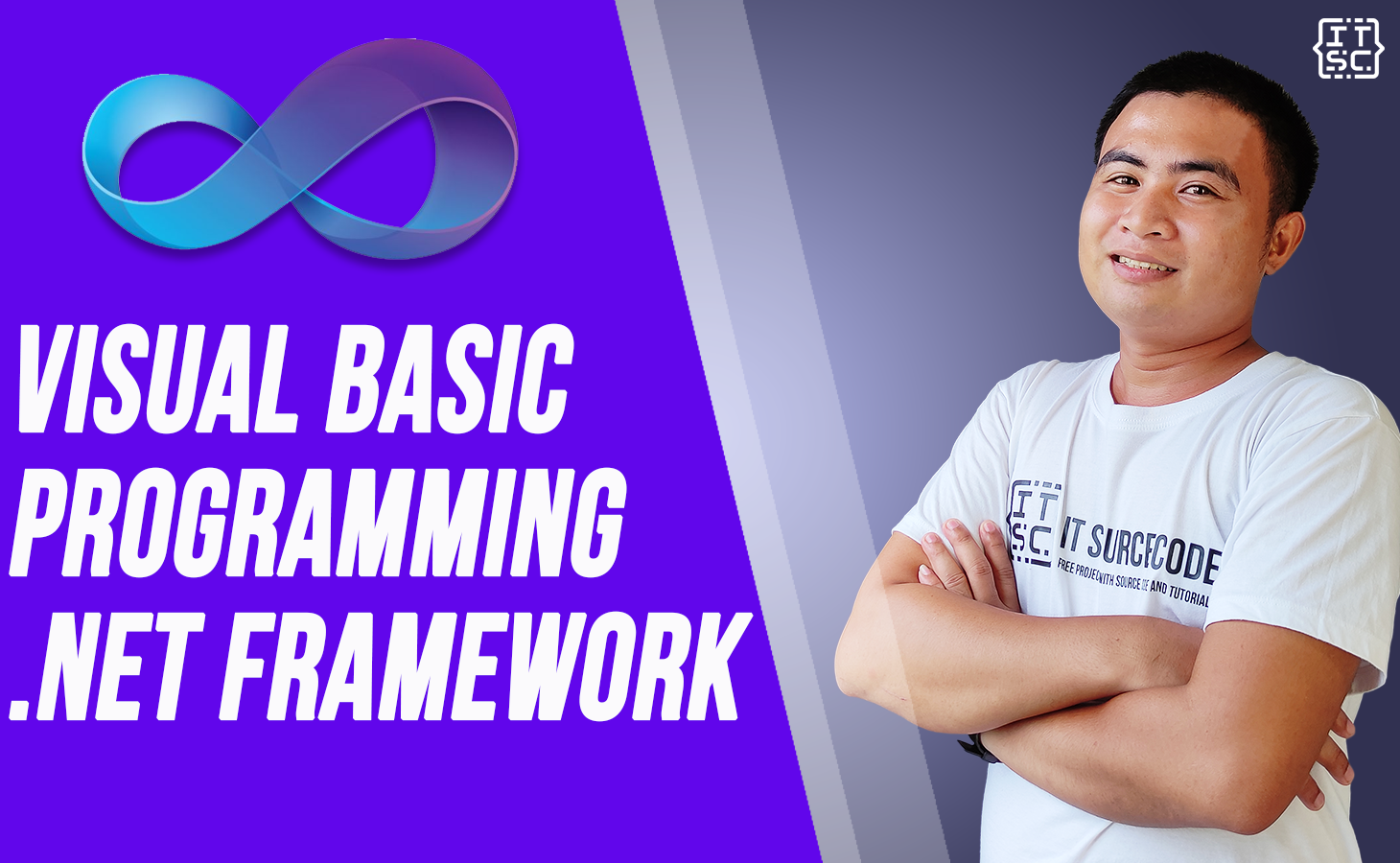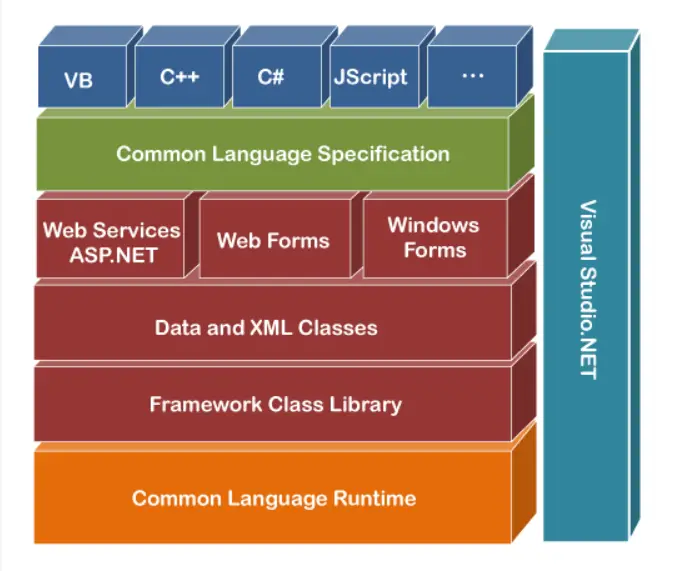What is .NET Framework?
The .NET Framework is a software development platform that was introduced by Microsoft in late 1990 under the NGWS.
On 13 February 2002, Microsoft launched the first version of the .NET Framework, referred to as the .NET Framework 1.0.
It is a virtual machine that provides a common platform to run an application that was built using different languages such as C#, VB.NET, Visual Basic, etc.
It is also used to create form-based, console-based, mobile, and web-based applications or services that are available in the Microsoft environment.
Furthermore, the .NET Framework is purely object-oriented, similar to the Java language. However, it is not a platform independent of Java. So, its application runs only on the Windows platform.
All these languages can access the framework as well as communicate with each other.
The .Net framework consists of an enormous library of codes used by the client languages like VB.Net. These languages use object-oriented methodology.
The main objective of this framework is to develop an application that can run on the Windows platform. The current version of the .Net framework is 4.8, 4.5, and 3.5.
What Does .NET Framework Do?
When first conceived and released, the Framework provided a standardized software development framework to facilitate Microsoft Windows development.
Today, the .NET product provides an open-source development framework for multiple channels.
Developed by the .NET Foundation and released under the MIT License, the Framework is intended to make development easier, faster, and more consistent.
There is a tremendous ecosystem connected to .NET, including:
- WPF (Windows Presentation Foundation). A user-interface tool that helps in designing Windows OS and Desktop applications.
- Windows Forms. GUI Library, which can be used for Windows desktop applications.
- ASP.NET Forms. A web application framework that helps in designing secure and accessible web-based applications.
Many developers find .NET a very powerful technology, especially now that it has become open-source.
But again, it shouldn’t be confused with Visual Studio, though the Visual Studio tool is the most visible component of the ecosystem.
A key difference is that Visual Studio actually supports more languages: HTML, CSS, JavaScript, PHP, and Python.
Types of Application
- Windows applications
- Web applications
- Web services
Components of .NET Framework
Following are some Components of the .NET Framework.
1. Common Language Runtime (CLR)
It is an important part of a .NET framework that works like a virtual component of the .NET Framework to execute different language programs like c#, Visual Basic, etc.
A CLR also helps to convert a source code into byte code, and this byte code is known as CIL (Common Intermediate Language) or MSIL (Microsoft Intermediate Language).
After converting into a byte code, a CLR uses a JIT compiler at run time that helps to convert a CIL or MSIL code into the machine or native code.
2. The .Net Framework Class Library
It provides various system functionalities in the .NET Framework, which includes classes, interfaces data types, etc. to create multiple functions and different types of applications such as desktop, web, mobile applications, etc.
In other words, it can be defined as, it provides a base on which various applications, controls, and components are built in .NET Framework.
3. Common Language Specification (CLS)
It is a subset of a common type system (CTS) that defines a set of rules and regulations that should be followed by every language that comes under the .net framework.
In other words, a CLS language should be cross-language integration or interoperability. For example, in C# and VB.NET language, the C# language terminates each statement with a semicolon, whereas in VB.NET it does not end with a semicolon, and when these statements execute in .NET Framework, it provides a common platform to interact and share information with each other.
4. Common Type System (CTS)
It specifies a standard that represents what type of data and value can be defined and managed in computer memory at runtime.
A CTS ensures that programming data defined in various languages should interact with each other to share information.
For example, in C# we define the data type as int, while in VB.NET we define an integer as a data type.
5. Base Class Library (BCL)
The Base Class Library has a rich collection of libraries features and functions that help to implement many programming languages in the .NET Framework, such as C #, F #, Visual C ++, and more.
BCL is divided into two parts:
- User-defined class library
- Assemblies – It is the collection of small parts of the deployment of an application’s part. It contains either the DLL (Dynamic Link Library) or exe (Executable) file.
- In LL, it uses code reusability, whereas in exe it contains only output file/ or application.
- DLL file can’t be opened, whereas an exe file can be opened.
- DLL file can’t be run individually, whereas, in exe, it can run individually.
- In a DLL file, there is no main method, whereas the exe file has the main method.
- Assemblies – It is the collection of small parts of the deployment of an application’s part. It contains either the DLL (Dynamic Link Library) or exe (Executable) file.
- Predefined class library
- Namespace – It is the collection of predefined classes and methods that are present in .Net. In other languages such as C, we used header files, in Java we used packages similarly we used “using the system” in .NET, where using is a keyword and system is a namespace.
6. .NET Assemblies
A .NET assembly is the main building block of the .NET Framework. It is a small unit of code that contains logically compiled code in the Common Language Infrastructure (CLI), which is used for deployment, security, and versioning.
It is defined in two parts (process) DLL and library (exe) assemblies. When the .NET program is compiled, it generates metadata with Microsoft Intermediate Language, which is stored in a file called Assembly.
7. XML Web Services
XML Web services are the fundamental building blocks in the move to distributed computing on the Internet.
Open standards and the focus on communication and collaboration among people and applications have created an environment where XML Web services are becoming the platform for application integration.
8. Window Services
A Windows service is a long-running application that can be started automatically when your system is started.
Characteristics of .NET Framework
1. CLR (Common Language Runtime)
2. Namespace – Predefined class and function
3. Metadata and Assemblies
4. Application domains
5. It helps to configure and deploy the .net application
6. It provides form and web-based services
7. NET and ASP.NET AJAX
8. LINQ
9. Security and Portability
10. Interoperability
11. It provides multiple environments for developing an application
.NET Framework Version
1. On 13 February 2002, Microsoft launched the first version of .NET Framework 1.0
2. The second version of .NET Framework 2.0 was launched on 22 January 2006
3. Third version of .NET Framework 3.0 was released on 21 November 2006
4. A .NET Framework 3.5 was released on 19 November 2007
5. Version of .NET Framework 4.0 was released on 29 September 2008
6. Version of .NET Framework 4.5 was released on 15 August 2012
7. .NET Framework 4.5.1 version was announced on 17 October 2013
8. On 5 May 2014, a version of .NET Framework 4.5.2 was released
9. .NET Framework 4.6 version was announced on 12 November 2014
10. .NET Framework 4.6.1 version was released on 30 October 2015
11. .NET Framework 4.6.2 version was announced on March 30, 2016
12. .NET Framework 4.7 version was announced on April 5, 2017
13. .NET Framework 4.7.1 version was announced on October 17, 2017
14. Version of .NET Framework 4.7.2 was released on 30 April 2018.
15. And currently we are using .NET Framework 4.8 which was released on 18 April 2019
Integrated Development Environment (IDE) For VB.net
Microsoft provides the following development tools for VB.net programming
- Visual Studio 2010 (VS)
- Visual Basic 2010 Express (VBE)
- Visual Web Developer
The last two are free. Using these tools, you can write all kinds of VB.Net programs from simple command-line applications to more complex applications.
Visual Basic Express and Visual Web Developer Express editions are trimmed-down versions of Visual Studio and have the same look and feel. They retain most features of Visual Studio.
In this tutorial, we have used Visual Basic 2010 Express and Visual Web Developer (for the web programming chapter).
You can download it from here. It gets automatically installed on your machine. Please note that you need an active internet connection to install the express edition.
Writing VB.net Programs on Linux or Mac OS
Although the .NET Framework runs on the Windows operating system, there are some alternative versions that work on other operating systems.
Mono is an open-source version of the .NET Framework which includes a Visual Basic compiler and runs on several operating systems, including various flavors of Linux and Mac OS. The most recent version is VB 2012.
The stated purpose of Mono is not only to be able to run Microsoft .NET applications cross-platform, but also to bring better development tools to Linux developers.
Mono can be run on many operating systems including Android, BSD, iOS, Linux, OS X, Windows, Solaris, and UNIX.
Summary
.NET is a programming language developed by Microsoft. It was designed to build applications that could run on the Windows platform.
The .NET programming language can be used to develop Forms-based applications, Web-based applications, and Web services.
Developers can choose from a variety of programming languages available on the Microsoft .NET framework platform.
The most common ones are VB.NET and C#.
PREVIOUS
NEXT





